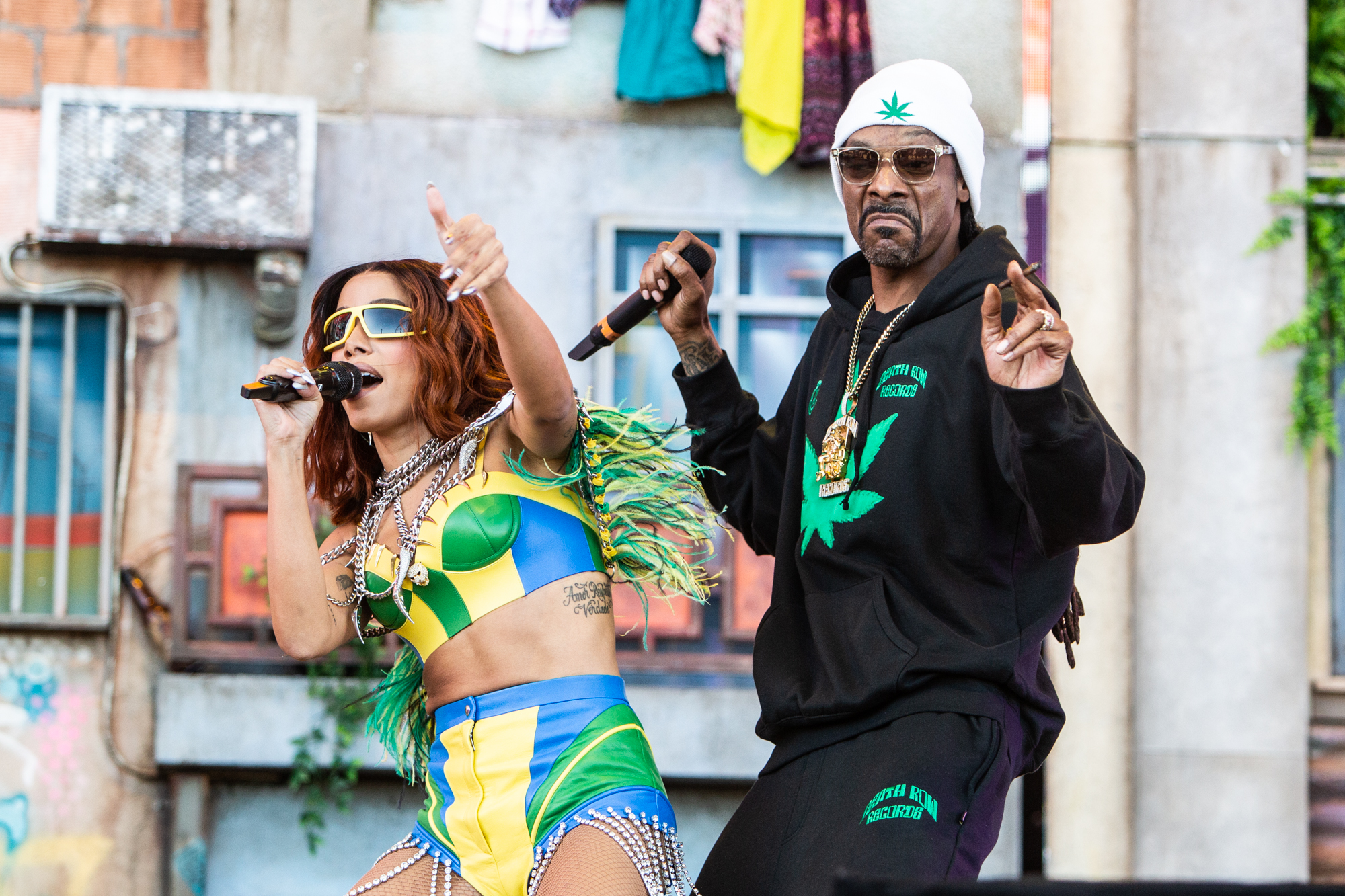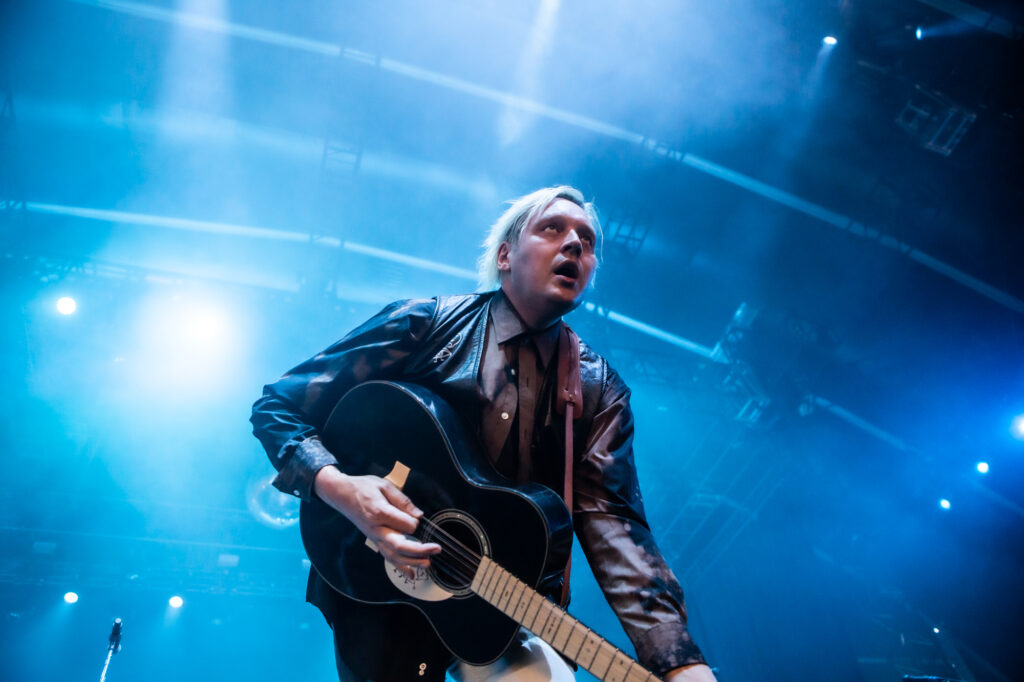During Arcade Fire’s joyous, surprise performance on Friday evening in the Mojave tent at Coachella, leader Win Butler took time to reflect (reflekt?). He recalled the band’s first performance at the event nearly 20 years prior in 2005, noting that they were just children back then. It’s the kind of realization that not many bands or artists are able to make at Coachella. Sure, someone like Richie Hawtin can trace his roots back to the first Coachella, but the vast majority of musicians don’t get to grow old with a music festival. If they aren’t sent out to pasture, there is certainly a nostalgia-based mico-genre fest waiting for them 20 years down the road.
Arcade Fire, of course, aren’t just any band. Their rise has always been inextricably linked to Coachella, this last weekend being their fifth total appearance, including headlining in 2010 and 2014. YouTube videos of those first couple performances in 2005 and 2007 are touchstones to how many people first experienced them, in a time when a conquering set at Coachella could help get you to a next level, whatever that is. Announced with just a day’s warning, the Canadian indie-rock icons played what is the equivalent of a Coachella underplay (they’ve recently been doing club shows in New York and their current home of New Orleans), filling up the modest Mojave instead of their usual Coachella Stage.
But despite their iconic status, there was still some concern about whether the young-leaning Coachella fans would even care. So, yes, it was heartening to see the Mojave overflowing, and even more so to find people singing along not just to the classics like “Rebellion (Lies)” and “Wake Up,” but also “Afterlife” and “The Suburbs.” It felt like exactly the moment the band needed after years of playing arenas, to see their music connecting in a space where the energy didn’t get lost in the rafters. The band looked Coachella straight in the eyes and found their commitment delivered back to them in spades.
But while the magic of their 65-minute performance can be attributed to many things — the surprise aspect, Arcade Fire’s live prowess, the glory of a sunset set in the desert — it also affirmed something a bit unexpected. Coachella, for the first time in more than a decade and in its 21st total installment, felt like a music festival for adults.
It doesn’t necessarily feel like the event was booked that way. Its headliners, particularly Harry Styles and Billie Eilish, are both closely tied to youth culture. Styles certainly tries to bridge the youth of today with those of decades past (he’s virtually always linking himself back to classic rock signifiers via style, album titles, even his collaborators and choices of cover songs), but as a live performer, he’s still used to playing for teens. Even at Coachella, there was a bit of overly-rehearsed canned banter that comes with the territory of playing for young people. In turn, it also felt like his headlining set was the least attended and talked about on the grounds. Eilish, in turn, only recently stopped being a teen herself. But she’s always been an outlier for her age group, which is probably why every aging male rocker under the sun wants to make it known in their interviews that they are a fan.
And maybe the headliners knew that this Coachella would be a different demographic than years past. Styles bringing out ’90s country-pop legend Shania Twain was certainly not a play for the zoomers hearts, nor was Billie’s decision to share the stage with Gorillaz’ Damon Albarn. Even the weekend’s sort-of-replacement headliners, Swedish House Mafia x The Weeknd, called back to Coachellas of a decade past as much as they served to highlight one of the biggest pop stars on the planet (SHM last played Coachella in 2012, the first year that The Weeknd performed at the festival). Meanwhile, teenagers’ favorite rapper-du-jour, Jack Harlow, was performing at a branded Coachella offshoot party a few miles down the road rather than on the grounds, in what can be seen as an oversight from bookers or a conscious decision based on perceived appeal.
It was almost like Coachella knew a vibe shift was coming. After three years away and two postponed editions — who knows if we’ll ever see Rage Against The Machine, Travis Scott, or Frank Ocean top the bill — the world of Coachella 2022 is very different than the world of the last Coachella in 2019. And while I’m not going to overly analyze all the factors that led to a notably older crowd, it feels like price point, pandemic job opportunities, and public health all have an impact on how all people approach large-scale events. And the festival went ahead and used some of its most coveted real estate — the big stages at sunset — to highlight the world of international music with 88rising’s Head In The Clouds Forever, Brazil’s Anitta, and Colombia’s Karol G. All three sets felt like landmark moments for their own cultures, and for music’s globalization, where sounds from different part of the world can all fit nicely in front of the same audience. And all felt more like testing the water than knowing for sure what would work best. Sure, dance acts like Flume and Disclosure still had huge audiences looking to groove, but it hardly felt like the revelry of the past, with people seemingly better aware of personal space and using the massive polo field to stretch out. Seeing fans pulled out of the audience, despite the sweltering heat, was rare. Never was there any fear of an Astroworld-esque crowd surge.

As someone that’s been covering Coachella for more than 10 years now, the festival’s M.O. has long been its ability to evolve. Sometimes, it is so ahead of the curve, people question whether Coachella has a plan at all. But then April hits and Harry Styles has the No. 1 song in the country (at least during the first weekend) and artists like Fred Again.., Carly Rae Jepsen, Japanese Breakfast, and 21 Savage all made their tents overflow with the kind of real-world interaction that can’t be inflated by Spotify listens or Instagram followers. Likewise, artists like Beach Bunny, 100 Gecs, Denzel Curry, Wallows, Finneas, and even our beloved Phoebe Bridgers didn’t manage to woo people in mass to their sets. Each of these musicians have had different pathways to the polo fields and different measurements for success. But it is still a curious thing that can only really be seen at a music festival, where musicians have to compete with each other, half-mile walks, and hand-dipped corndogs for attention. It’s definitely not as easy as getting someone to click follow or maintaining passive attention on a curated playlist.
Whether Coachella’s next phase is to reinvent itself for the next group of young people or to age with its current audience remains to be seen, but for this year at least, there was something special in the air. People seemed appreciative to have music festivals at all, soaking in the moments rather than blacking them out. Of all the awful shit we’ve had to deal with since 2020, the hope coming out of it was that we’d be a little better as a culture, that we wouldn’t take things for granted. Arcade Fire, a band that somewhat unfairly lost the good will it had built in the aughts, understands this. Fred Again.., who wasn’t even releasing music before the pandemic, also gets it. Doja Cat, the star-of-the-moment that did the best job of securing that title over the weekend, for sure gets this. She didn’t waste time in her set for a contrived special guest that had little to do with her performance, but instead put on fellow oddball Rico Nasty, who in turn got to play in front of what is surely the biggest audience of her life. For maybe the first time ever, Coachella was able to look backward and forward at the same time, the kind of self-reflection (self-reflektion? sorry) that only comes in adulthood. Coachella felt all grown up, and ready for whatever comes next.
Check out our exclusive gallery of Coachella 2022 photos below.

